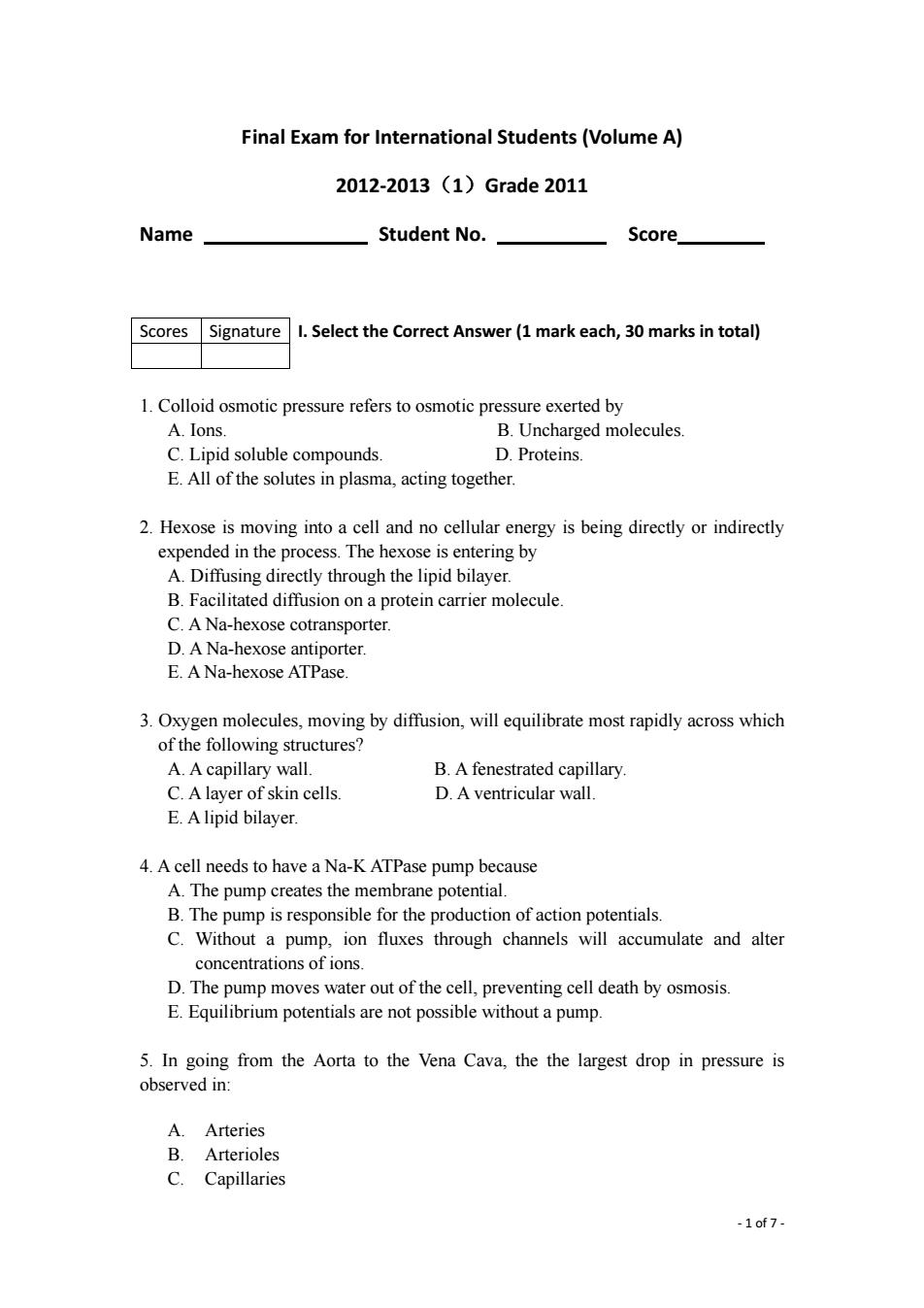
Final Exam for International students (Volume A) 2012-2013(1)Grade2011 Name Student No. Score Scores Signature 1.Select the Correct Answer(1 mark each,30 marks in total) 1.Colloid osmotic pressure refers to osmotic pressure exerted by A.Ions B.Uncharged molecules C.Lipid soluble compounds. D.Proteins. E.All of the solutes in plasma,acting together. 2.Hexose is moving into a cell and no cellular energy is being directly or indirectly expended in the process.The hexose is entering by A.Diffusing directly through the lipid bilaver. B.Facilitated diffusion on a protein carrier molecule C.A Na-hexose cotransporter D A Na-hex ose antinorte E.A Na-hexose ATPase 3.Oxygen molecules,moving by diffusion,will equilibrate most rapidly across which of the following structures? a.a capillary wall B.a fenestrated capillary C.A layer of skin cells D.A ventricular wall. E.A lipid bilayer 4.A cell needs to have a Na-K ATPase pump because A.The pump creates the membrane potential. B.The pump is responsible for the roduction of action potentials C.Without a pump.ion fluxes through channels will accumulate and alter concentrations of ions. D.The pump moves water out of the cell.preventing cell death by osmosis. E.Equilibrium potentials are not possible without a pump. 5.In going from the Aorta to the Vena Cava,the the largest drop in pressure is observed in: A.Arteries B.Arterioles C.Capillaries -1of7-
‐ 1 of 7 ‐ Final Exam for International Students (Volume A) 2012‐2013(1)Grade 2011 Name Student No. Score 1. Colloid osmotic pressure refers to osmotic pressure exerted by A. Ions. B. Uncharged molecules. C. Lipid soluble compounds. D. Proteins. E. All of the solutes in plasma, acting together. 2. Hexose is moving into a cell and no cellular energy is being directly or indirectly expended in the process. The hexose is entering by A. Diffusing directly through the lipid bilayer. B. Facilitated diffusion on a protein carrier molecule. C. A Na-hexose cotransporter. D. A Na-hexose antiporter. E. A Na-hexose ATPase. 3. Oxygen molecules, moving by diffusion, will equilibrate most rapidly across which of the following structures? A. A capillary wall. B. A fenestrated capillary. C. A layer of skin cells. D. A ventricular wall. E. A lipid bilayer. 4. A cell needs to have a Na-K ATPase pump because A. The pump creates the membrane potential. B. The pump is responsible for the production of action potentials. C. Without a pump, ion fluxes through channels will accumulate and alter concentrations of ions. D. The pump moves water out of the cell, preventing cell death by osmosis. E. Equilibrium potentials are not possible without a pump. 5. In going from the Aorta to the Vena Cava, the the largest drop in pressure is observed in: A. Arteries B. Arterioles C. Capillaries Scores Signature I. Select the Correct Answer (1 mark each, 30 marks in total)
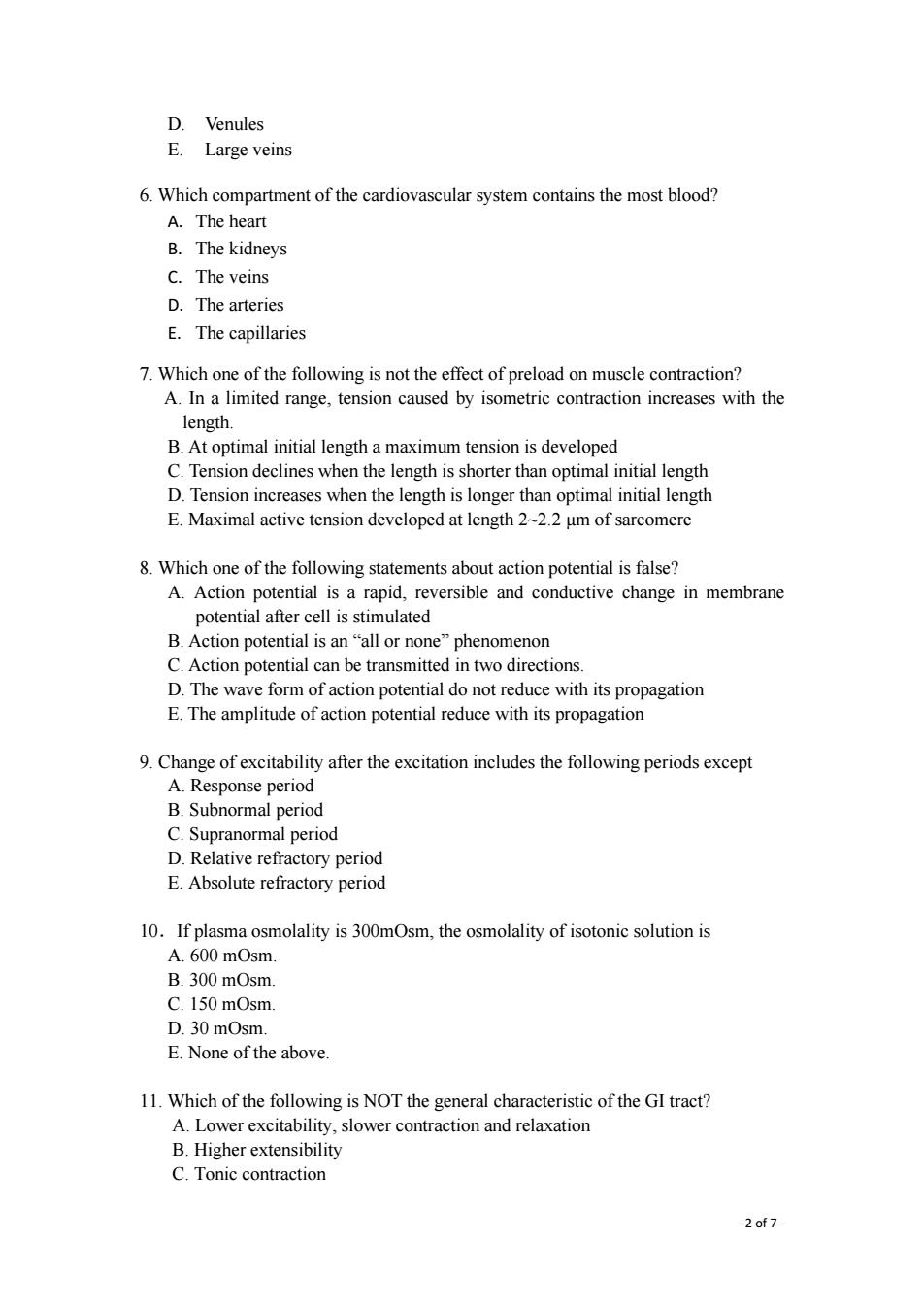
D.Venules E.Large veins 6.Which compartment of the cardiovascular system contains the most blood? A.The heart B.The kidneys C.The veins D.The arteries E.The capillaries 7.Which one of the following is not the effect of preload on muscle contraction? A.In a limited range,tension caused by isometric contraction increases with the length B.At optimal initial length a maximum tension is developed C.Tension declines whe en the ength is shorter than optim al initial lengt D.Tension increases when the length is longer than optimal initial length E.Maximal active tension developed at length 2~2.2 um of sarcomere 8.Which one of the following statements about action potential is false? A.Action tential is rapid,reversible and conductive change in membrane B.Action potential is an"all or none"phenomenon C.Action potential can be transmitted in two directions. D.The wave form of action potential do not reduce with its propagation E.The amplitude of action potential reduce with its propagation 9.Change of excitability after the excitation includes the following periods except A.Response period B Subnormal period C.Supranormal period D.Relative refractory period E.Absolute refractory period 10.If plasma osmolality is 300mOsm,the osmolality of isotonic solution is A.600m0sm. B 300 mOsm C.150 mOsm D.30mOsm E.None of the above 11.Which of the following is NOT the general characteristic of the GI tract? A.Lowe slower contraction and relaxatior B.Higher extensibility C.Tonic contraction -2f7
‐ 2 of 7 ‐ D. Venules E. Large veins 6. Which compartment of the cardiovascular system contains the most blood? A. The heart B. The kidneys C. The veins D. The arteries E. The capillaries 7. Which one of the following is not the effect of preload on muscle contraction? A. In a limited range, tension caused by isometric contraction increases with the length. B. At optimal initial length a maximum tension is developed C. Tension declines when the length is shorter than optimal initial length D. Tension increases when the length is longer than optimal initial length E. Maximal active tension developed at length 2~2.2 µm of sarcomere 8. Which one of the following statements about action potential is false? A. Action potential is a rapid, reversible and conductive change in membrane potential after cell is stimulated B. Action potential is an “all or none” phenomenon C. Action potential can be transmitted in two directions. D. The wave form of action potential do not reduce with its propagation E. The amplitude of action potential reduce with its propagation 9. Change of excitability after the excitation includes the following periods except A. Response period B. Subnormal period C. Supranormal period D. Relative refractory period E. Absolute refractory period 10.If plasma osmolality is 300mOsm, the osmolality of isotonic solution is A. 600 mOsm. B. 300 mOsm. C. 150 mOsm. D. 30 mOsm. E. None of the above. 11. Which of the following is NOT the general characteristic of the GI tract? A. Lower excitability, slower contraction and relaxation B. Higher extensibility C. Tonic contraction
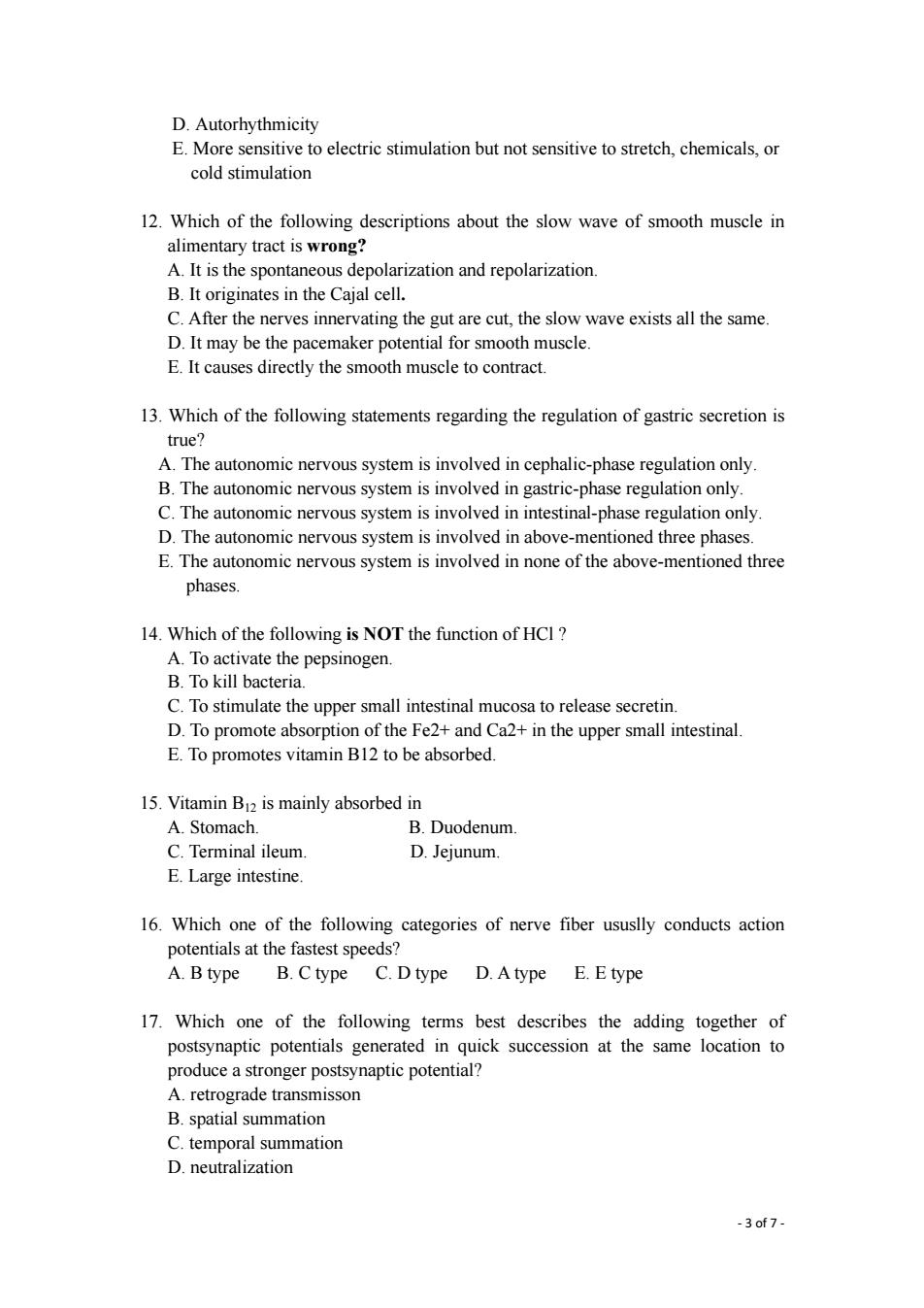
D.Autorhythmicity E.More sensitive to electric stimulation but not sensitive to stretch,chemicals,or cold stimulatio 12.Which of the following descriptions about the slow wave of smooth muscle in alimentary tract is wrong? A.It is the spontaneous depolarization and repolarization. C.After the nerves innervating the gut are cut,the slow wave exists all the same D.It may be the pacemaker potential for smooth muscle E.It causes directly the smooth muscle to contract. 13.Which of the following statements regarding the regulation of gastric secretion is true? A.The autonomic nervous system is involved in cephalic-phase regulation only. B.The autonomic nervous system is involved in gastric-phase regulation only. C.The autonomic nervous system is involved in intestinal-phase regulation only D.The autonomic nervous system is involved in above-mentioned three phases E.Theautonomic nervous system is involved of the above-mentioned three phases. 14.Which of the following is NOT the function of HCI? A.To activate the pepsinogen. B.To kill bacteria C.To stimulate the upper small intestinal mucosa to release secretin D.To promote absorption of the Fe2+and Ca2+in the upper small intestinal E.To promotes vitamin B12 to be absorbed. 15.Vitamin B2 is mainly absorbed in A.Stomach B.Duodenum C.Terminal ileum D.Jejunum. E.Large intestine 16.Which one of the following categories of nerve fiber ususlly conducts action B.Ctype C.Dtype D.Atype E.Etype 17.Which one of the following terms best describes the adding together of postsynaptic potentials generated in quick succession at the same location to produce onger postsynaptic potential? A.retrograde transmissor B.spatial summation C.temporal summation D.neutralization -3of7
‐ 3 of 7 ‐ D. Autorhythmicity E. More sensitive to electric stimulation but not sensitive to stretch, chemicals, or cold stimulation 12. Which of the following descriptions about the slow wave of smooth muscle in alimentary tract is wrong? A. It is the spontaneous depolarization and repolarization. B. It originates in the Cajal cell. C. After the nerves innervating the gut are cut, the slow wave exists all the same. D. It may be the pacemaker potential for smooth muscle. E. It causes directly the smooth muscle to contract. 13. Which of the following statements regarding the regulation of gastric secretion is true? A. The autonomic nervous system is involved in cephalic-phase regulation only. B. The autonomic nervous system is involved in gastric-phase regulation only. C. The autonomic nervous system is involved in intestinal-phase regulation only. D. The autonomic nervous system is involved in above-mentioned three phases. E. The autonomic nervous system is involved in none of the above-mentioned three phases. 14. Which of the following is NOT the function of HCl ? A. To activate the pepsinogen. B. To kill bacteria. C. To stimulate the upper small intestinal mucosa to release secretin. D. To promote absorption of the Fe2+ and Ca2+ in the upper small intestinal. E. To promotes vitamin B12 to be absorbed. 15. Vitamin B12 is mainly absorbed in A. Stomach. B. Duodenum. C. Terminal ileum. D. Jejunum. E. Large intestine. 16. Which one of the following categories of nerve fiber ususlly conducts action potentials at the fastest speeds? A. B type B. C type C. D type D. A type E. E type 17. Which one of the following terms best describes the adding together of postsynaptic potentials generated in quick succession at the same location to produce a stronger postsynaptic potential? A. retrograde transmisson B. spatial summation C. temporal summation D. neutralization
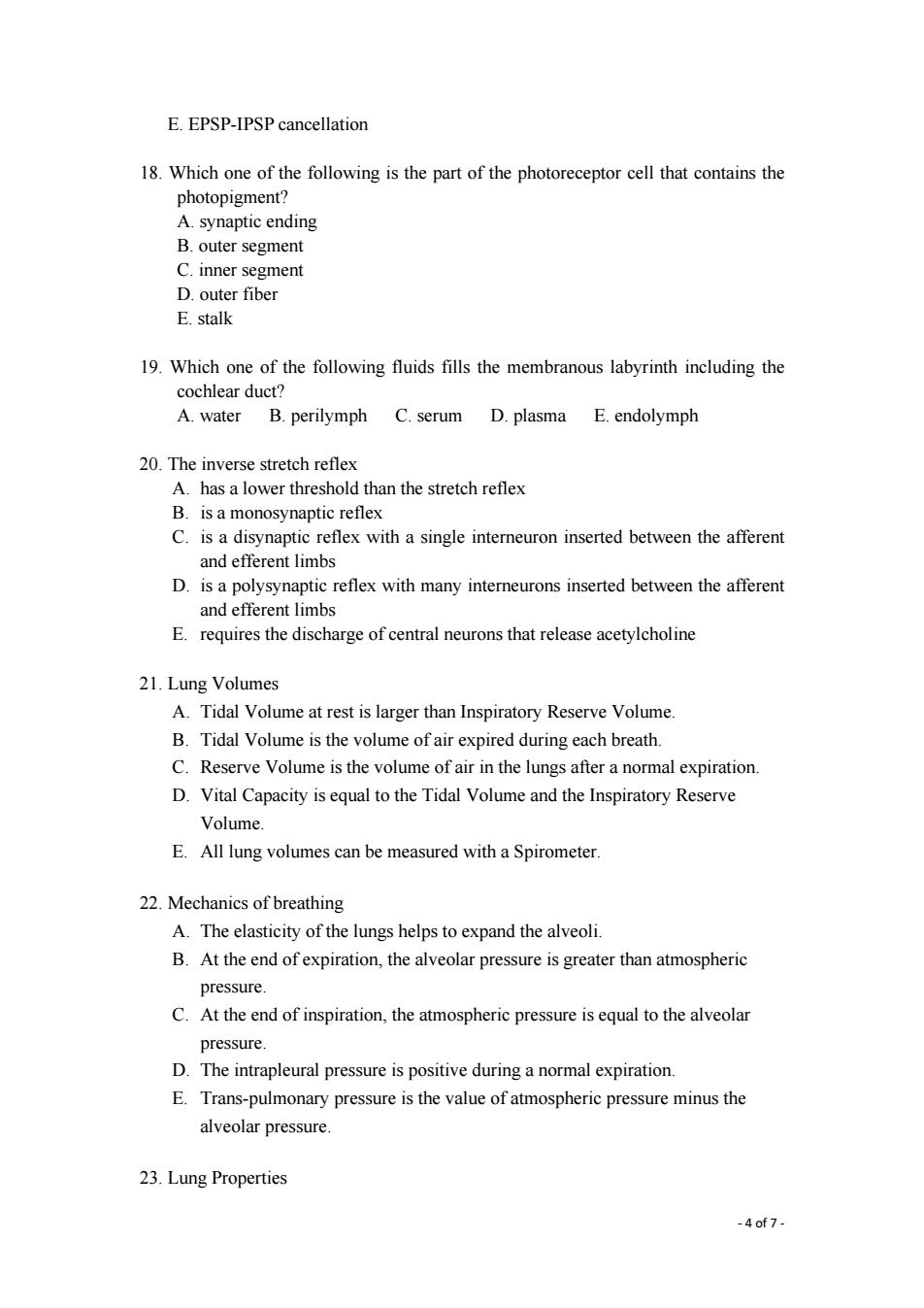
E.EPSP-IPSP cancellation 18.Which one of the following is the part of the photoreceptor cell that contains the photopigment? A.synaptic ending B.outer segment C.inner segment D.outer fibe E.stalk 19.Which one of the following fluids fills the membranous labyrinth including the cochlear duct? A.water B.perilymph C.serum D.plasma E.endolymph 20.The inverse stretch reflex A.has a lower threshold than the stretch reflex B.is a monosynaptic reflex C.is a dis reflex with a single interneuron inserted between the afferent and efferent limbs D.is a polysynaptic reflex with many interneurons inserted between the afferent and efferent limbs E.requires the discharge of central neurons that release acetylcholine 21.Lung Volumes A.Tidal Volume at rest is larger than Inspiratory Reserve Volume. B.Tidal Volume is the volume of air expired during each breath. C.Reserve Volume is the volume of air in the lungs after a normal expiration D.Vital Capacity isequal to the Tidal Volume and the Inspiratory Reserve Volume E.All lung volumes can be measured with a Spirometer. 22.Mechanics of breathing A.The elasticity of the lungs helps to expand the alveoli. B.At the end of expiration,the alveolar pressure is greater than atmospheric pressure C.At the end of inspiration,the atmospheric pressure is equal to the alveolar pressure D.The intrapleural pressure is positive during a normal expiration E.Trans-pulmonary pressure is the value of atmospheric pressure minus the alveolar pressure 23.Lung Properties -4of7
‐ 4 of 7 ‐ E. EPSP-IPSP cancellation 18. Which one of the following is the part of the photoreceptor cell that contains the photopigment? A. synaptic ending B. outer segment C. inner segment D. outer fiber E. stalk 19. Which one of the following fluids fills the membranous labyrinth including the cochlear duct? A. water B. perilymph C. serum D. plasma E. endolymph 20. The inverse stretch reflex A. has a lower threshold than the stretch reflex B. is a monosynaptic reflex C. is a disynaptic reflex with a single interneuron inserted between the afferent and efferent limbs D. is a polysynaptic reflex with many interneurons inserted between the afferent and efferent limbs E. requires the discharge of central neurons that release acetylcholine 21. Lung Volumes A. Tidal Volume at rest is larger than Inspiratory Reserve Volume. B. Tidal Volume is the volume of air expired during each breath. C. Reserve Volume is the volume of air in the lungs after a normal expiration. D. Vital Capacity is equal to the Tidal Volume and the Inspiratory Reserve Volume. E. All lung volumes can be measured with a Spirometer. 22. Mechanics of breathing A. The elasticity of the lungs helps to expand the alveoli. B. At the end of expiration, the alveolar pressure is greater than atmospheric pressure. C. At the end of inspiration, the atmospheric pressure is equal to the alveolar pressure. D. The intrapleural pressure is positive during a normal expiration. E. Trans-pulmonary pressure is the value of atmospheric pressure minus the alveolar pressure. 23. Lung Properties
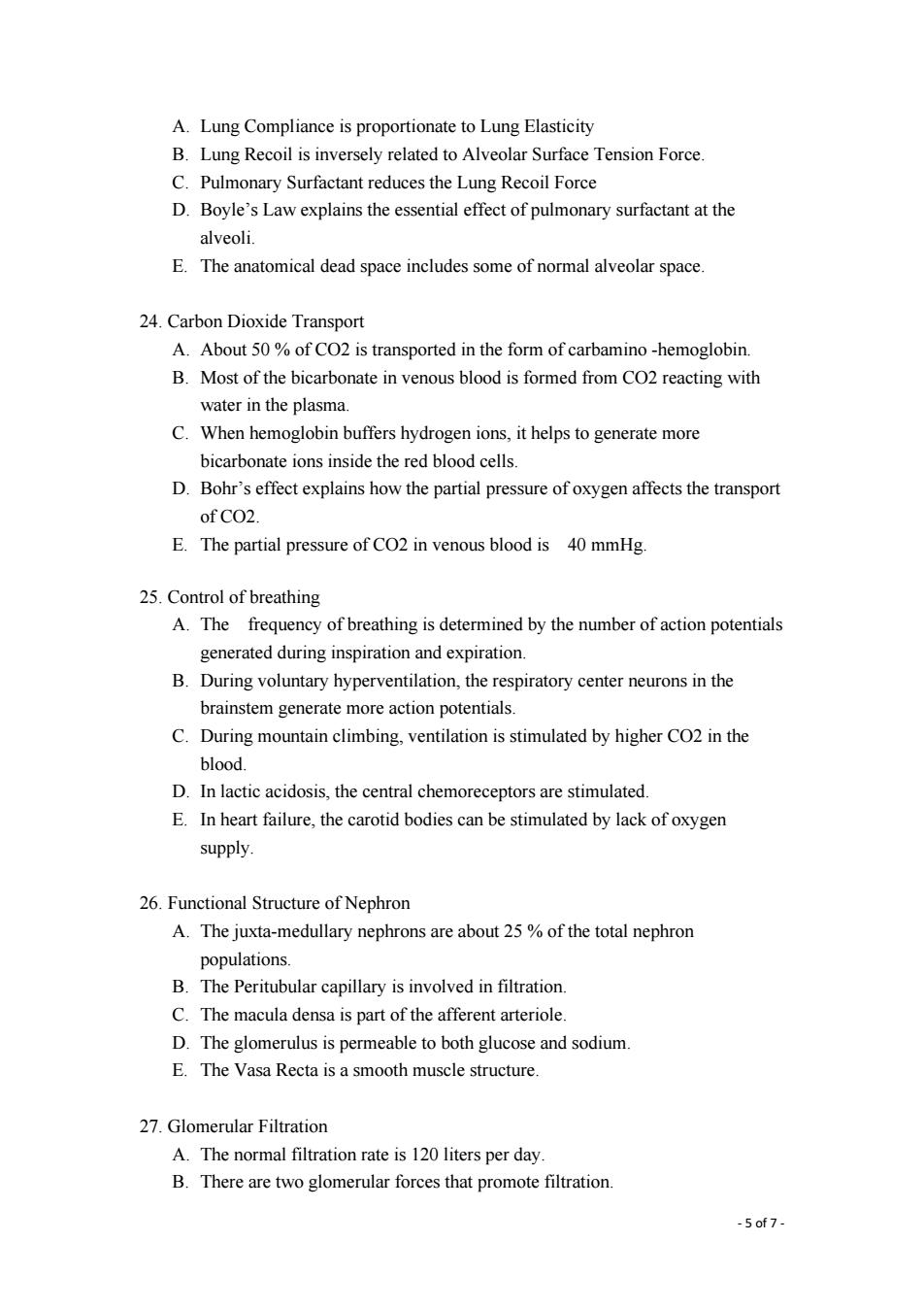
A.Lung Compliance is proportionate to Lung Elasticity B.Lung Recoil is inversely related to Alveolar Surface Tension Force. C.Pulmonary Surfactant reduces the Lung Recoil Force D.Boyle's Law explains the essential effect of pulmonary surfactant at the alveoli. E.The anatomical dead space includes some of normal alveolar space. 24.Carbon Dioxide Transport A.About 50%ofCO2 is transported in the form of carbamino-hemoglobin B.Most of the bicarbonate in venous blood is formed from CO2 reacting with water in the plasma C.When hemoglobin buffers hydrogen ions,it helps to generate more bicarbonate ions inside the red blood cells D.Bohr's effect explains how the partial pressure of oxygen affects the transport of CO2. E.The partial pressure of CO2 in venous blood is 40 mmHg. 25.Control of breathing A.The frequency of breathing is determined by the number of action potentials generated during inspiration and expiration B.During voluntary hyperventilation,the respiratory center neurons in the brainstem generate more action potentials C.During mountain climbing.ventilation is stimulated by higher CO2 in the blood. D.In lactic acidosis,the central chemoreceptors are stimulated. E.In heart failure,the carotid bodies can be stimulated by lack of oxygen supply. 26.Functional Structure of Nephron A.The juxta-medullary nephrons are about 25%of the total nephron populations B.The Peritubular capillary is involved in filtration. C.The macula densa is part of the afferent arteriole D.The glomerulus is permeable to both glucose and sodium E.The Vasa Recta is a smooth muscle structure 27.Glomerular Filtration A.The normal filtration rate is 120 liters per day. B.There are two glomerular forces that promote filtration -5of7
‐ 5 of 7 ‐ A. Lung Compliance is proportionate to Lung Elasticity B. Lung Recoil is inversely related to Alveolar Surface Tension Force. C. Pulmonary Surfactant reduces the Lung Recoil Force D. Boyle’s Law explains the essential effect of pulmonary surfactant at the alveoli. E. The anatomical dead space includes some of normal alveolar space. 24. Carbon Dioxide Transport A. About 50 % of CO2 is transported in the form of carbamino -hemoglobin. B. Most of the bicarbonate in venous blood is formed from CO2 reacting with water in the plasma. C. When hemoglobin buffers hydrogen ions, it helps to generate more bicarbonate ions inside the red blood cells. D. Bohr’s effect explains how the partial pressure of oxygen affects the transport of CO2. E. The partial pressure of CO2 in venous blood is 40 mmHg. 25. Control of breathing A. The frequency of breathing is determined by the number of action potentials generated during inspiration and expiration. B. During voluntary hyperventilation, the respiratory center neurons in the brainstem generate more action potentials. C. During mountain climbing, ventilation is stimulated by higher CO2 in the blood. D. In lactic acidosis, the central chemoreceptors are stimulated. E. In heart failure, the carotid bodies can be stimulated by lack of oxygen supply. 26. Functional Structure of Nephron A. The juxta-medullary nephrons are about 25 % of the total nephron populations. B. The Peritubular capillary is involved in filtration. C. The macula densa is part of the afferent arteriole. D. The glomerulus is permeable to both glucose and sodium. E. The Vasa Recta is a smooth muscle structure. 27. Glomerular Filtration A. The normal filtration rate is 120 liters per day. B. There are two glomerular forces that promote filtration

C.The glomerular hydrostatic pressure is about 25 mmHg D.The glomerular oncotic pressure is due to plasma protein concentration. E.Filtration process requires ATPase 28.Renin Angiotensin System(RAS) A.Renin is secreted by the macula densa of the juxta-glomerular apparatus. B.In negative sodium balance,plasma renin level will be high. C.Increased renal perfusion pressure will stimulate renin secretion D.Angiotensin II is produced by the adrenal cortex E.Angiotensin II is a dipsogenic and a vasodilator. 29.Renal Autoregulation A.This mechanism maintains renal perfusion pressure. B.This mechanism requires renal sympathetic nerve activity. C.This mechanism needs circulating angiotensin II. D.This mechanism controls both renal blood flow and glomerular filtration. E.This mechanism increases the secretion of renin 30.Kidney Functions A.In kidney failure,the pH of blood will increase. B.The kidneys secrete less erythropoietin during hypoxia C.Osmoreceptors involved in water balance are found in the kidneys. D.Sodium sensors involved in sodium balance are located in the kidneys E.Both receptors for aldosterone and vasopressin are located at the collecting ducts. Scores.Define the concepts(5 marks each,30 marks in total) 1.Effective refractory period 2.Cardiac output -6of7-
‐ 6 of 7 ‐ C. The glomerular hydrostatic pressure is about 25 mmHg. D. The glomerular oncotic pressure is due to plasma protein concentration. E. Filtration process requires ATPase. 28. Renin Angiotensin System (RAS) A. Renin is secreted by the macula densa of the juxta-glomerular apparatus. B. In negative sodium balance, plasma renin level will be high. C. Increased renal perfusion pressure will stimulate renin secretion D. Angiotensin II is produced by the adrenal cortex. E. Angiotensin II is a dipsogenic and a vasodilator. 29. Renal Autoregulation A. This mechanism maintains renal perfusion pressure. B. This mechanism requires renal sympathetic nerve activity. C. This mechanism needs circulating angiotensin II. D. This mechanism controls both renal blood flow and glomerular filtration. E. This mechanism increases the secretion of renin. 30. Kidney Functions A. In kidney failure, the pH of blood will increase. B. The kidneys secrete less erythropoietin during hypoxia. C. Osmoreceptors involved in water balance are found in the kidneys. D. Sodium sensors involved in sodium balance are located in the kidneys. E. Both receptors for aldosterone and vasopressin are located at the collecting ducts. Scores Signature I I. Define the concepts (5 marks each, 30 marks in total) 1. Effective refractory period 2. Cardiac output

3.Glomerular effective filtration pressure 4.Gastric emptying 5.Referred pain 6.Dark Adaptation Scores Signature Ill Answers the following questions(10 marks each,40 marks in total) 1.Please describe the steps of signal transmission at the neuromuscular junction. 2.Please describe the procedure and significance of Baroreceptor Reflexes. 3.Compare the functional characteristics of rods and cones. 4.What are the two types of postsynaptic inhibition?Please explain their mechanisms. -7of7-
‐ 7 of 7 ‐ 3. Glomerular effective filtration pressure 4. Gastric emptying 5. Referred pain 6. Dark Adaptation Scores Signature III Answers the following questions(10 marks each, 40 marks in total) 1. Please describe the steps of signal transmission at the neuromuscular junction. 2. Please describe the procedure and significance of Baroreceptor Reflexes. 3. Compare the functional characteristics of rods and cones . 4. What are the two types of postsynaptic inhibition? Please explain their mechanisms